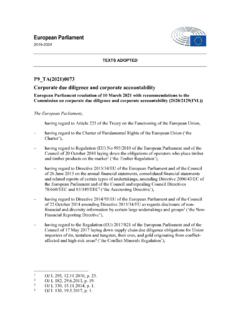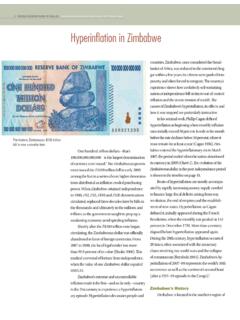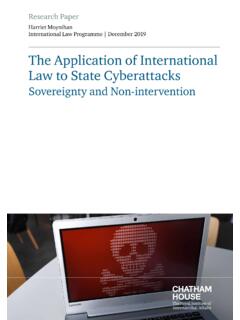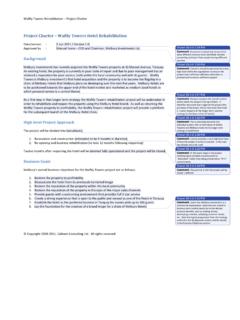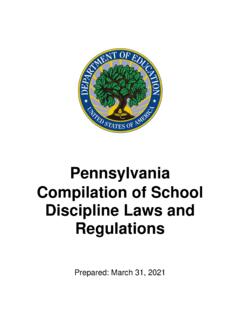Transcription of MEMORANDUM OF UNDERSTANDING - ed
1 MEMORANDUM OF UNDERSTANDING . BETWEEN. DEPARTMENT OF DEFENSE. AND. DEPARTMENT OF EDUCATION. I. Purpose: The purpose of this MEMORANDUM of UNDERSTANDING (MOU) is to establish a framework for collaboration between the Department of Defense (DoD) and the Department of Education (ED) to address the quality of education and the unique challenges faced by children of military families. In addition, the MOU will provide a mechanism to assist communities and local educational agencies (LEAs) as they prepare for projected increases in military dependent students 1 at military installations due to Base Realignment and Closure (BRAC), Global Defense Posture Realignment (GDPR), and Grow the Force. The agencies share a goal of coordinated interagency and intergovernmental assistance to respond to education needs that may arise with this growth at the local level and to support war fighters and their families.
2 This MOU defines, in general terms, the basis on which these Departments will work together to strengthen and expand school-based efforts to ease student transitions and help military students develop academic skills that will last a lifetime and coping skills to help during deployment periods. Approximately 1,118,000 school-aged military students2. (including dependents of active and reserve components) will benefit from these activities. II. Authority: DoD: Section 574 of Public Law ( ) 109-364, as amended; 10 113; DoD Directive ; DoD Directive ; 10 2192; 10 . 2391; 12788, as amended. ED: 20 3475 and 12788, as amended. III. Background: Current military rebasing initiatives will relocate large numbers of military families and affect an increasing number of LEAs that educate military children. The rebasing impact provides an opportunity for DoD and ED to support LEAs and military communities in pursuit of quality education through the examination and sharing of successful educational options and best practices.
3 Section 574 of the John Warner National Defense Authorization Act (NDAA) for Fiscal Year (FY) 2007 ( 109-364) directs the Secretary of Defense to work collaboratively 1. 109-364 574 (e)(3), as amended the term military dependent students refers to (A) elementary and secondary school students who are dependents of members of the Armed Forces, (B) elementary and secondary school students who are dependents of civilian employees of the Department of Defense; and (C) elementary and secondary school students who are dependents of personnel who are not members of the Armed Forces or civilian employees of the Department of Defense but who are employed on Federal property.. 2. Defense Manpower Data Center 2008. 1. with the Secretary of Education in efforts to ease the transition of military dependent students from attendance in DoD dependent schools to attendance in schools of LEAs.
4 Under section 2391 of title 10, United States Code, the Secretary of Defense may make grants, conclude cooperative agreements, and supplement other Federal funds in order to assist a State or local government to provide community planning assistance in areas where base closure and realignment occurs or in other limited instances. In accordance with section 2192 of title 10, United States Code, the Secretary of Defense, in consultation with the Secretary of Education shall, on a continuing basis, identify actions which DoD may take to improve education in the scientific, mathematics, and engineering skills necessary to meet the long-term national defense needs of the , and establish and conduct programs to carry out such actions. IV. Objectives: This MOU supports both agencies' efforts to: Promote and enhance policies that will improve military children's education and overall well-being.
5 Advance the quality of educational opportunities for all military children;. Provide research-based academic, social-emotional and behavioral supports to facilitate seamless transitions for military children;. Provide leadership and advocacy programs to help military students cope with issues surrounding deployments;. Support foreign language education, including programs for strategic languages;. Assist military parents to be informed advocates of quality education choices;. Explore legislative options to address transition issues for military children;. Extend opportunities for student learning through support of online/virtual and other research-based models;. Provide research-based teacher and administrator professional development programs;. Forge effective partnerships with schools and districts;. Coordinate the DoD and ED Impact Aid programs.
6 Communicate with military families and organizations to show appreciation for their contributions;. Increase awareness of resources and tools available from ED and DoD. V. Responsibilities: Both ED and the DoD are committed to working together to create, expand, and improve quality education opportunities and to collect and disseminate best practices that address the challenges of children of military families. DoD and ED will work together in the following areas: 1. Quality Education 2. a. Coordinate efforts to share and implement research-based educational best practices and professional development especially in the areas of mathematics, science, and literacy. b. Promote the National Security Language Initiative. c. Collaborate to ensure that policies are implemented to support military students with special needs.
7 D. Serve as a resource for communities exploring alternative methods for the delivery of educational services, such as charter schools. e. Strengthen and promote parental involvement with the education of school- aged children and youth. f. Collaborate on the development and promotion of professional development opportunities for teachers of military students. 2. Student Transition and Deployment a. Explore options to mitigate the effects of daily attendance requirements for military students affected by deployment. b. Implement an enhanced and more effectively coordinated effort to support military families of deployed service members to include Guard, Reserve and those geographically dispersed, including providing research-based academic, social-emotional and behavioral supports to facilitate seamless transitions for military children.
8 C. Encourage school districts and states to adopt polices and practices that minimize the impact of frequent transitions. d. Collaborate on professional development opportunities to increase awareness of student transition and deployment issues related to the military students. 3. Data a. Identify educational service needs that states, communities, and school districts may experience as a result of expected military growth. b. Explore approaches for the collection, disaggregation, and analysis of military student educational data. c. Develop, monitor, and share projections of military, civilian, and Federal contractor student data as they relate to impacted installations, communities, and LEAs. d. Monitor, analyze, and share specific data that Department of the Army works to develop and provide to ED and the Office of Economic Adjustment (OEA).
9 Regarding projections of Army military, civilian, and associated Federal contractor dependent student data as they relate to the identified installations, communities, and LEAs. The Department of the Army will also work to establish a system to obtain and share actual installation military dependent student data with ED and OEA for comparison with ED's data captured from LEAs through the annual Impact Aid survey. These data will assist the ED. 3. Impact Aid planning process by establishing trends to compare Army and LEA. data actuals. 4. Communication and Outreach a. Create joint communication, outreach, and training strategies to keep parents, educators, students, military leaders, and other stakeholders informed about tools and resources available from ED and DoD. b. Enhance parental awareness about the significance of their involvement in the academic success of their children and in improving their schools.
10 C. Raise awareness among educators and community leaders about the impact of deployment and transfers on student achievement. 5. Resources a. Afford priority consideration, as authorized by laws and regulations, to requests for Federal technical assistance, financial resources, excess or surplus property, or other requirements 3 to assist States, communities, and LEAs respond to the impact of military growth, as authorized by law and regulation. b. Enhance awareness and provide training opportunities for military-connected communities to compete for Federal funding, including but not limited to grants available under such programs as those for charter schools, professional development, foreign language, online learning, and STEM (science, technology, engineering, and mathematics) education. c. Continue to coordinate interagency and intergovernmental assistance to respond to the educational needs that may arise with military growth.

